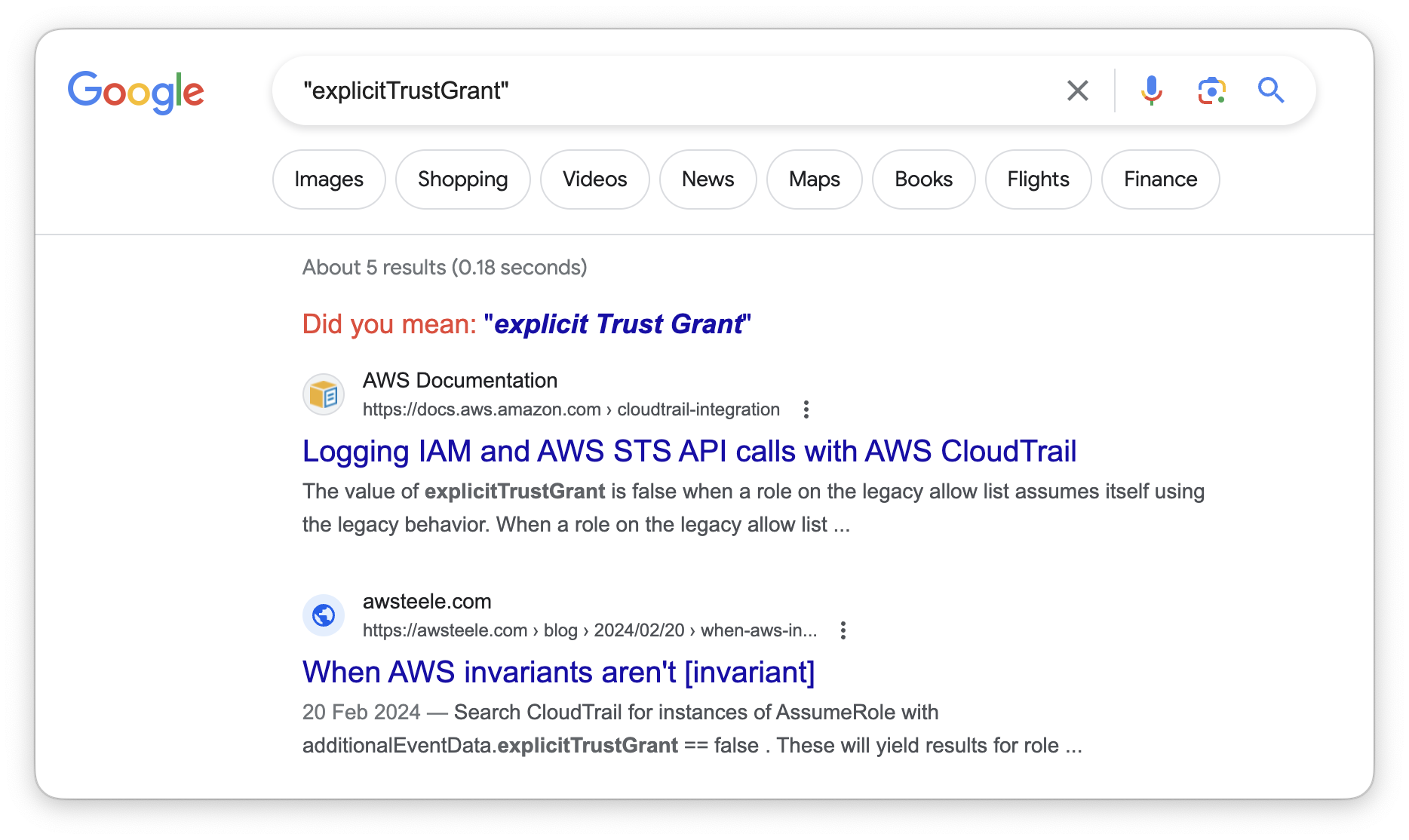When AWS invariants aren't [invariant]
Update (14 March, 2024)¶
The AWS Security Outreach team contacted me to say that they've heard this
feedback and the situation has improved. explicitTrustGrant is now
documented and appears on Google. I've also updated my quotes from
Arkadiy's article to reflect his changes. I continue to be impressed by Amazon's
responsiveness to feedback published on some random personal blogs.
tl;dr¶
Search CloudTrail for instances of AssumeRole with
additionalEventData.explicitTrustGrant == false. These will yield results
for role assumptions that aren't permitted by the trust policy, i.e. the
ones that are going to surprise you - and violate your invariants like "role
session names will always be an employee's email address".
Not quite invariant¶
Arkadiy Tetelman recently published a very interesting blog post on detecting manual actions undertaken by humans in his AWS environment. It's worth reading: if you haven't already, read it first and then come back here.
I want to draw attention to two things he said, because they recently caught me out and I suspect they might be surprising to others. This is the first:
The only way that employees can access AWS is through Okta / AssumeRoleWithSAML. There are no other mechanisms for an employee to get access to AWS (zero IAM users, etc)
When someone assumes an employee role, Okta is configured to set the AWS role session name to be the employee email address
The above two conditions are an invariant for employee access to AWS.
The second is this:
Also until very recently roles implicitly trusted themselves from a role trust policy perspective (so if they had identity-based permissions to assume themselves, they could do so without an explicit grant in their trust policy, or vice versa), which similarly allowed some roles to change their own role session name.
The AWS blog that Arkadiy links to actually briefly mentions that the implicit allowed self-assumption behaviour is still present for some roles - and it's not easy to find out which roles that applies to. This is what caught me out: I had some roles that still had the grandfathered-in implicit self-assumption allowed and I had no idea.
The AWS blog shares an AWS Athena query that can be used to identify instances of role self-assumption, but this isn't helpful in a large enterprise: there will be many false positives, because it will also return instances of self-assumption that is permitted by explicit statements in the role's trust policy. We only want to identify roles that are still relying on the implicit behaviour.
It turns out that it is actually possible to identify the implicit behaviour, but
I only stumbled across it by accident when reviewing CloudTrail logs. It wasn't
documented on the Internet at the time I originally wrote this post, but AWS has
since documented explicitTrustGrant and it appears in search results.

Email¶
In the interest of searchability, I've reproduced the email from Amazon here:
We contacted you previously regarding an AWS Identity and Access Management (IAM) change delivered on September 21, 2022 that updated an aspect of how role trust policy evaluation behaves when a role assumes itself. With this change, role assumption always requires an explicit role trust policy grant. At that time, we identified one or more roles in this account relying on implicit trust when the role assumes itself. These roles were placed on a temporary allow list to prevent AssumeRole calls from being denied due to the new trust policy evaluation behavior. We advised you to make any necessary changes to your existing processes, code, or configurations to prepare for elimination of the implicit trust behavior. For more information about this behavior change in your account, please review additional details in the blog post "Announcing an Update to IAM Role Trust Policy Behavior" [1].
On February 3, 2023, we announced that starting June 30, 2023, all roles, regardless of allow list status, that attempt to assume themselves will fail with an access denied error unless the role trust policy explicitly grants the permission and the conditions and actions are satisfied.
We are contacting you again to announce that rather than enforcing an explicit trust grant for all roles regardless of allow list status starting June 30, 2023, we will instead automatically remove roles from the allow list based on observed role assumption behavior. Roles on the allow list that we observe either not performing role self-assumption or whose trust policy grants explicit trust with every role assumption over the previous 90 days or more are candidates for removal. A role that performs self-assumption without granting explicit trust at least once over the previous 90 days will be retained on the allow list to give you additional time to make the necessary code or configuration changes. As we announced on December 20, 2022, you can verify whether a specific role self-assumption call by an allow-listed role grants explicit trust by reviewing the corresponding CloudTrail entry and observing a value of “true” for the “explicitTrustGrant” flag.
Automatic removal of candidate roles from the allow list that match the criteria defined above begins on June 30, 2023. You may choose to remove a role from the allow list prior to its identification as a removal candidate if its role assumption behavior matches your use case expectations. For assistance with removing such roles from the allow list, please contact AWS Support [2].
Once a role is removed from the allow list, its role assumption calls will always require an explicit trust grant.